Tribological Properties of Hard TiB2 Thin Films Prepared at Low Temperatures Using HiPIMS
Abstract
:1. Introduction
2. Materials and Methods
2.1. Preparation of the Film
2.2. Structural, Compositional Characterization and Mechanical Properties of the Thin Film
2.3. Tribological Properties of the Thin Film
3. Results and Discussion
3.1. Morphological and Phase Analysis of the TiB2 Thin Film
3.2. Mechanical Properties of the TiB2 Thin Film
3.3. Analysis of the Bonding Force between the TiB2 Thin Film and Substrate
3.4. Tribological Properties of the TiB2 Thin Film
3.4.1. Tribological Properties of the TiB2 Thin Film under Different Loads
3.4.2. Tribological Properties of the TiB2 Thin Film at Different Sliding Frequencies
4. Conclusions
Author Contributions
Funding
Institutional Review Board Statement
Informed Consent Statement
Data Availability Statement
Conflicts of Interest
References
- Akhtar, S.S. A critical review on self-lubricating ceramic-composite cutting tools. Ceram. Int. 2021, 47, 20745–20767. [Google Scholar] [CrossRef]
- Liu, X.; Wang, Y.; Qin, L.; Guo, Z.; Lu, Z.; Zhao, X.; Dong, H.; Xiao, Q. Friction and wear properties of a novel interface of ordered microporous Ni-based coating combined with MoS2 under complex working conditions. Tribol. Int. 2023, 189, 108970. [Google Scholar] [CrossRef]
- Kumar, A.; Kumar, M.; Tailor, S. Self-lubricating composite coatings: A review of deposition techniques and material advancement. In Materials Today: Proceedings; Elsevier: Amsterdam, The Netherlands, 2023. [Google Scholar] [CrossRef]
- Yan, Z.; Liu, J.; Zhang, X.; Hao, J.; Liu, W. WS2-Ti-based solid-liquid synergetic lubricating coating with super-high wear resistance for space application. Surf. Coat. Technol. 2024, 476, 130245. [Google Scholar] [CrossRef]
- Zhao-yun, Z.; Ze-wen, D.; Hai-xia, J.; Bei-bei, Z.; Xiao-yu, Z.; You-zhi, W.; Peng, W. The Influence of Doped Ti Element on Structure and Tribological Properties of WS2 Film. Surf. Technol. 2022, 51, 239–247+266. [Google Scholar]
- Mingling, X.; Guang’an, Z.; Xing, S.; Xi, T.; Xiaoping, G.; Yuzhe, S. Anti-oxidization and Electronic Properties of Ti Doped MoS2 Films. Chin. J. Mater. Res. 2021, 35, 59–64. [Google Scholar]
- Deepthi, B.; Barshilia, H.C.; Rajam, K.S.; Konchady, M.S.; Kvit, A.V. Structure, morphology and chemical composition of sputter deposited nanostructured Cr–WS2 solid lubricant coatings. Surf. Coat. Technol. 2010, 205, 565–574. [Google Scholar] [CrossRef]
- Cui, S.; Li, W.-S.; He, L.; Feng, L.; An, G.-S.; Hu, W.; Hu, C.-X. Tribological behavior of a Ni-WS2 composite coating across wide temperature ranges. Rare Met. 2019, 38, 1078–1085. [Google Scholar] [CrossRef]
- Li, P.; Xu, F.; Robertson, S.; Zhou, Z.; Hou, X.; Clare, A.T.; Aboulkhair, N.T. Metallurgical reactions and tribological properties of self-lubricating Al-WS2 composites: Laser powder bed fusion Vs. spark plasma sintering. Mater. Des. 2022, 216, 110543. [Google Scholar] [CrossRef]
- Li, S.; Deng, J.; Yan, G.; Zhang, K.; Zhang, G. Microstructure, mechanical properties and tribological performance of TiSiN–WS2 hard-lubricant coatings. Appl. Surf. Sci. 2014, 309, 209–217. [Google Scholar] [CrossRef]
- Bibeye Jahaziel, R.; Krishnaraj, V.; Sudhagar, S.; Geetha Priyadarshini, B. Improving dry machining performance of surface modified cutting tools through combined effect of texture and TiN-WS2 coating. J. Manuf. Process. 2023, 85, 101–108. [Google Scholar] [CrossRef]
- Serra, E.C.; Soares, V.F.D.; Fernandez, D.A.R.; Hübler, R.; Juste, K.R.C.; Lima, C.L.; Tentardini, E.K. Influence of WS2 content on high temperature wear performance of magnetron sputtered TiN-WSx thin films. Ceram. Int. 2019, 45, 19918–19924. [Google Scholar] [CrossRef]
- Xie, Z.-W.; Wang, L.-P.; Wang, X.-F.; Huang, L.; Lu, Y.; Yan, J.-C. Mechanical performance and corrosion behavior of TiAlSiN/WS2 multilayer deposited by multi-plasma immersion ion implantation and deposition and magnetron sputtering. Trans. Nonferrous Met. Soc. China 2011, 21, s470–s475. [Google Scholar] [CrossRef]
- Sala, N.; Abad, M.D.; Sánchez-López, J.C.; Crugeira, F.; Ramos-Masana, A.; Colominas, C. Influence of the carbon incorporation on the mechanical properties of TiB2 thin films prepared by HiPIMS. Int. J. Refract. Met. Hard Mater. 2022, 107, 105884. [Google Scholar] [CrossRef]
- Wu, Z.; Ye, R.; Bakhit, B.; Petrov, I.; Hultman, L.; Greczynski, G. Reprint of: Improving oxidation and wear resistance of TiB2 films by nano-multilayering with Cr. Surf. Coat. Technol. 2022, 442, 128602. [Google Scholar] [CrossRef]
- Polyakov, M.N.; Morstein, M.; Maeder, X.; Nelis, T.; Lundin, D.; Wehrs, J.; Best, J.P.; Edwards, T.E.J.; Döbeli, M.; Michler, J. Microstructure-driven strengthening of TiB2 coatings deposited by pulsed magnetron sputtering. Surf. Coat. Technol. 2019, 368, 88–96. [Google Scholar] [CrossRef]
- Ozkan, D.; Yilmaz, M.A.; Bakdemir, S.A.; Sulukan, E. Wear and Friction Behavior of TiB2 Thin Film–Coated AISI 52100 Steels under the Lubricated Condition. Tribol. Trans. 2020, 63, 1008–1019. [Google Scholar] [CrossRef]
- Jinhui, D.; Wang, P.; Yin, L.; Feng, H.; Xikun, Y. Microstructure and friction properties of WS2/TiB2 solid self-lubricant coating. Heat Treat. Met. 2016, 41, 104–109. [Google Scholar]
- Jin-long, L.; Hong-xuan, L.; Li, J.; Xiao-hong, L.; Ding-jun, Z. Tribological Properties of TiB2 Doped WS2 Composite Films in Wide Temperature Range. Surf. Technol. 2023, 52, 235–245. [Google Scholar]
- Dorri, S.; Palisaitis, J.; Greczynski, G.; Petrov, I.; Birch, J.; Hultman, L.; Bakhit, B. Oxidation kinetics of overstoichiometric TiB2 thin films grown by DC magnetron sputtering. Corros. Sci. 2022, 206, 110493. [Google Scholar] [CrossRef]
- Hellgren, N.; Zhirkov, I.; Sortica, M.A.; Petruhins, A.; Greczynski, G.; Hultman, L.; Rosen, J. High-power impulse magnetron sputter deposition of TiBx thin films: Effects of pulse length and peak current density. Vacuum 2024, 222, 113070. [Google Scholar] [CrossRef]
- Feng, A.X.; Zhang, Y.K.; Xie, H.K.; Fan, Z. Characterization of Interfacial Adhesion and Bond Strength between Thin Film Coating and Substrate by Scratch Testing. J. Jiangsu Univ. (Nat. Sci. Ed.) 2003, 24, 15–19. [Google Scholar]
- Ge, F.; Zhu, P.; Wang, H.; Meng, F.; Li, S.; Huang, F. Friction and wear behavior of magnetron co-sputtered V–Si–N coatings. Wear 2014, 315, 17–24. [Google Scholar] [CrossRef]
- Nedfors, N.; Primetzhofer, D.; Zhirkov, I.; Palisaitis, J.; Persson, P.O.Å.; Greene, J.E.; Petrov, I.; Rosen, J. The influence of pressure and magnetic field on the deposition of epitaxial TiBx thin films from DC magnetron sputtering. Vacuum 2020, 177, 109355. [Google Scholar] [CrossRef]
- Leyland, A.; Matthews, A. On the significance of the H/E ratio in wear control: A nanocomposite coating approach to optimised tribological behaviour. Wear 2000, 246, 1–11. [Google Scholar] [CrossRef]
- Lenz, B.; Hasselbruch, H.; Großmann, H.; Mehner, A. Application of CNN networks for an automatic determination of critical loads in scratch tests on a-C:H:W coatings. Surf. Coat. Technol. 2020, 393, 125764. [Google Scholar] [CrossRef]
- Bird, A.; Yang, L.; Wu, G.; Inkson, B.J. Failure mechanisms of diamond like carbon coatings characterised by in situ SEM scratch testing. Wear 2023, 530–531, 205034. [Google Scholar] [CrossRef]
- Zawischa, M.; Makowski, S.; Kuczyk, M.; Weihnacht, V. Comparison of fracture properties of different amorphous carbon coatings using the scratch test and indentation failure method. Surf. Coat. Technol. 2022, 435, 128247. [Google Scholar] [CrossRef]
- Kabir, M.S.; Zhou, Z.; Xie, Z.; Munroe, P. Scratch adhesion evaluation of diamond like carbon coatings with alternate hard and soft multilayers. Wear 2023, 518-519, 204647. [Google Scholar] [CrossRef]
- Lin-xiu, G. Introduction to the wear loss of metal materials and protection measures. Dev. Guide Build. Mater. 2020, 18, 25–26. [Google Scholar]
- Chi, X.; Yuan, J.; Li, J.; Pan, G.; Cui, Y.; Li, X. Effect of Cu on the high-temperature wear behavior of FeAl-TiB2 coatings produced by extreme high-speed laser cladding. Appl. Surf. Sci. Adv. 2023, 17, 100439. [Google Scholar] [CrossRef]
- Bao, Y.; Huang, L.; An, Q.; Zhang, R.; Geng, L.; Ma, X.; Tang, G.; Zhang, H. Wear resistance of TiB/Ti composite coating fabricated by TIG cladding using Ti-TiB2 cored wire. Surf. Coat. Technol. 2023, 474, 130086. [Google Scholar] [CrossRef]
- Chen, L.; Zhang, X.; Zheng, W.; Wang, M.; Liu, B.; Sun, W. Investigation on corrosion behaviors and mechanical properties of TiB2/7075Al composites with various particle contents. J. Mater. Res. Technol. 2023, 23, 2911–2923. [Google Scholar] [CrossRef]

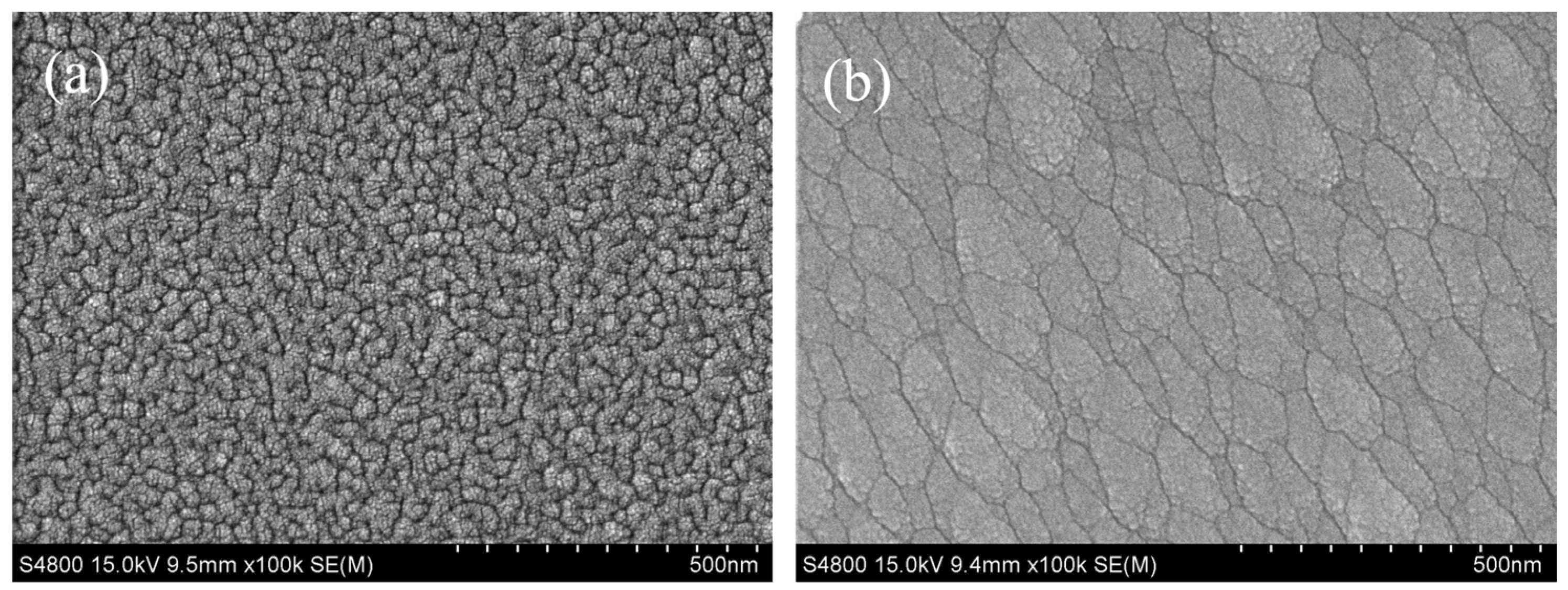


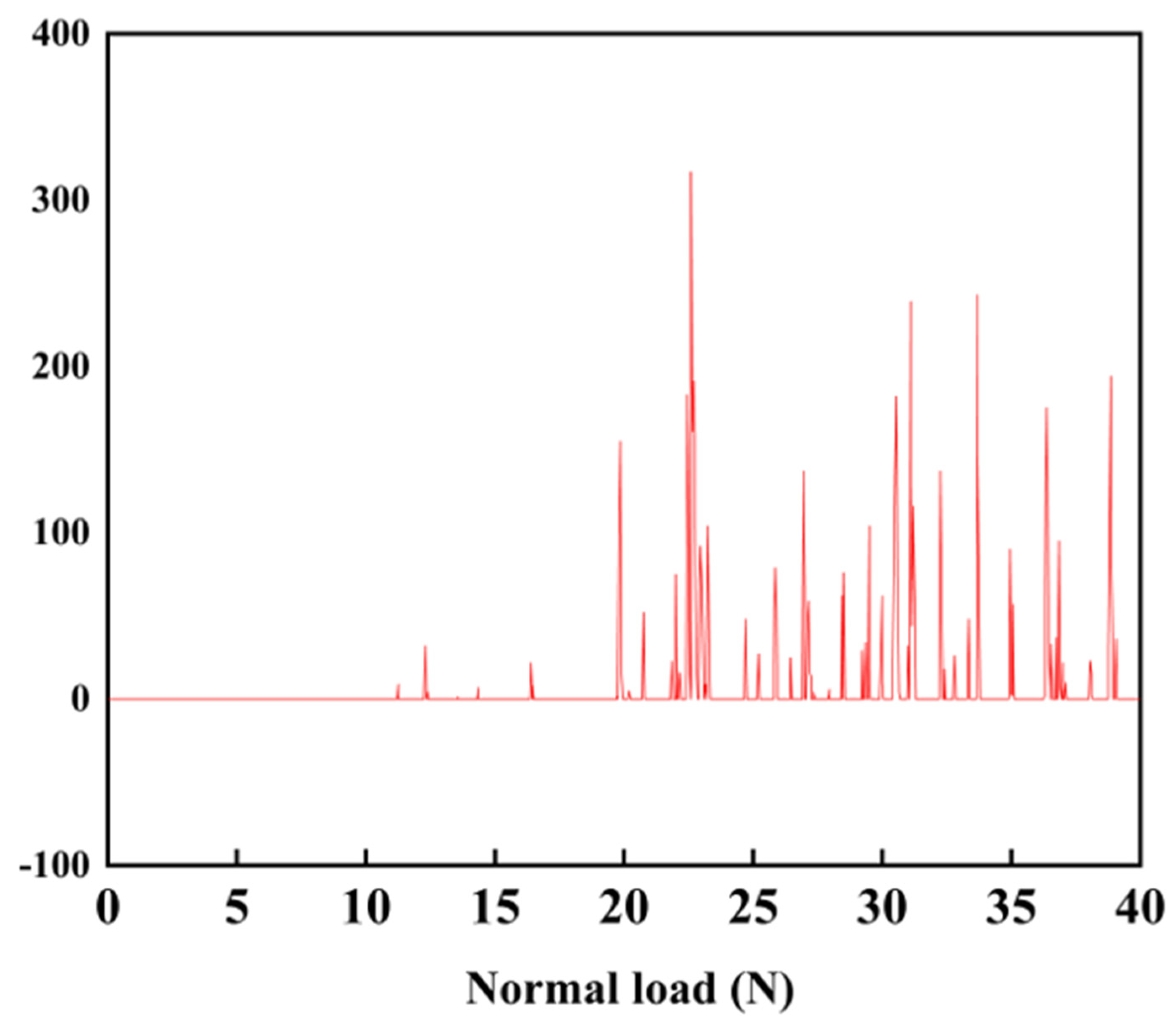

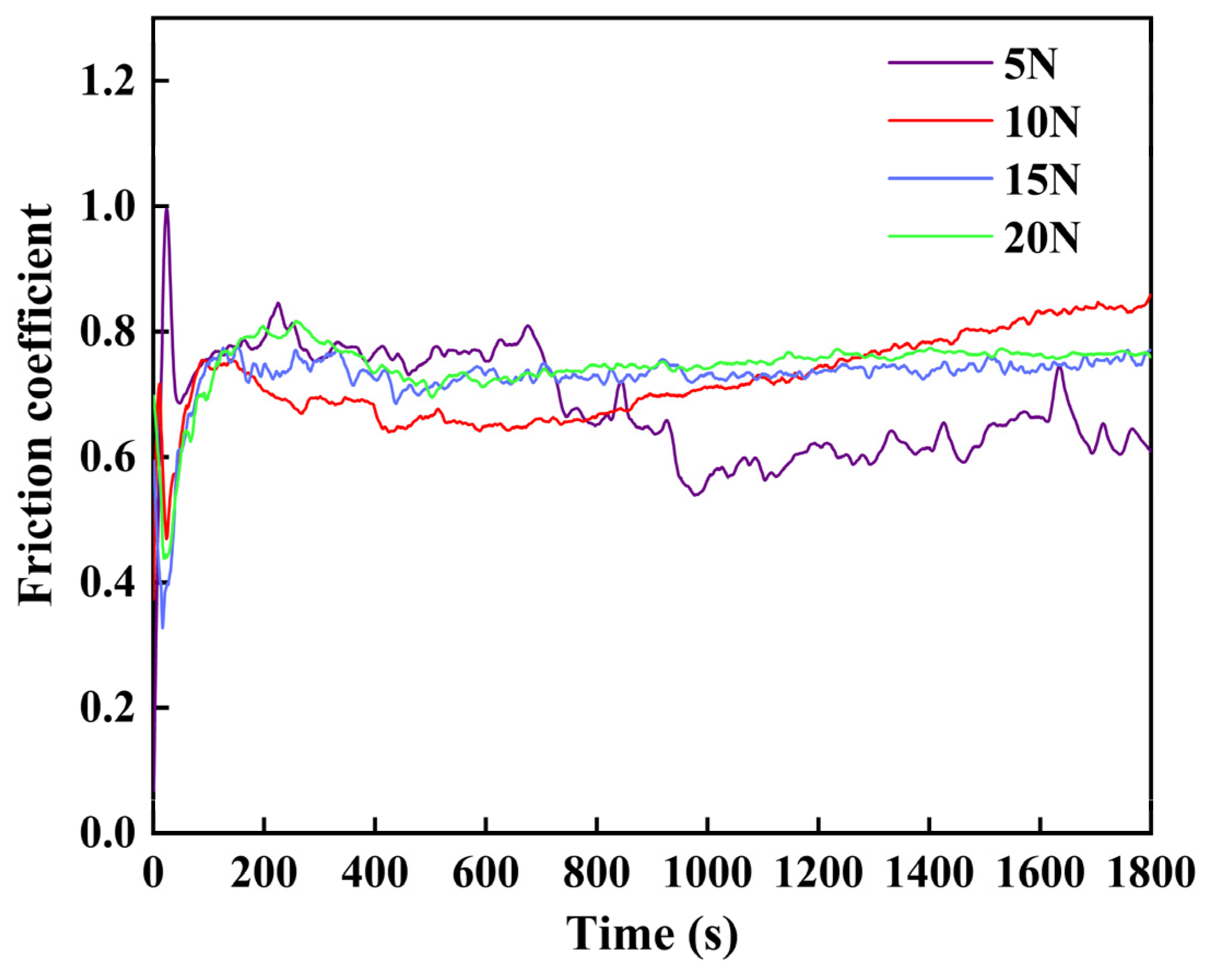
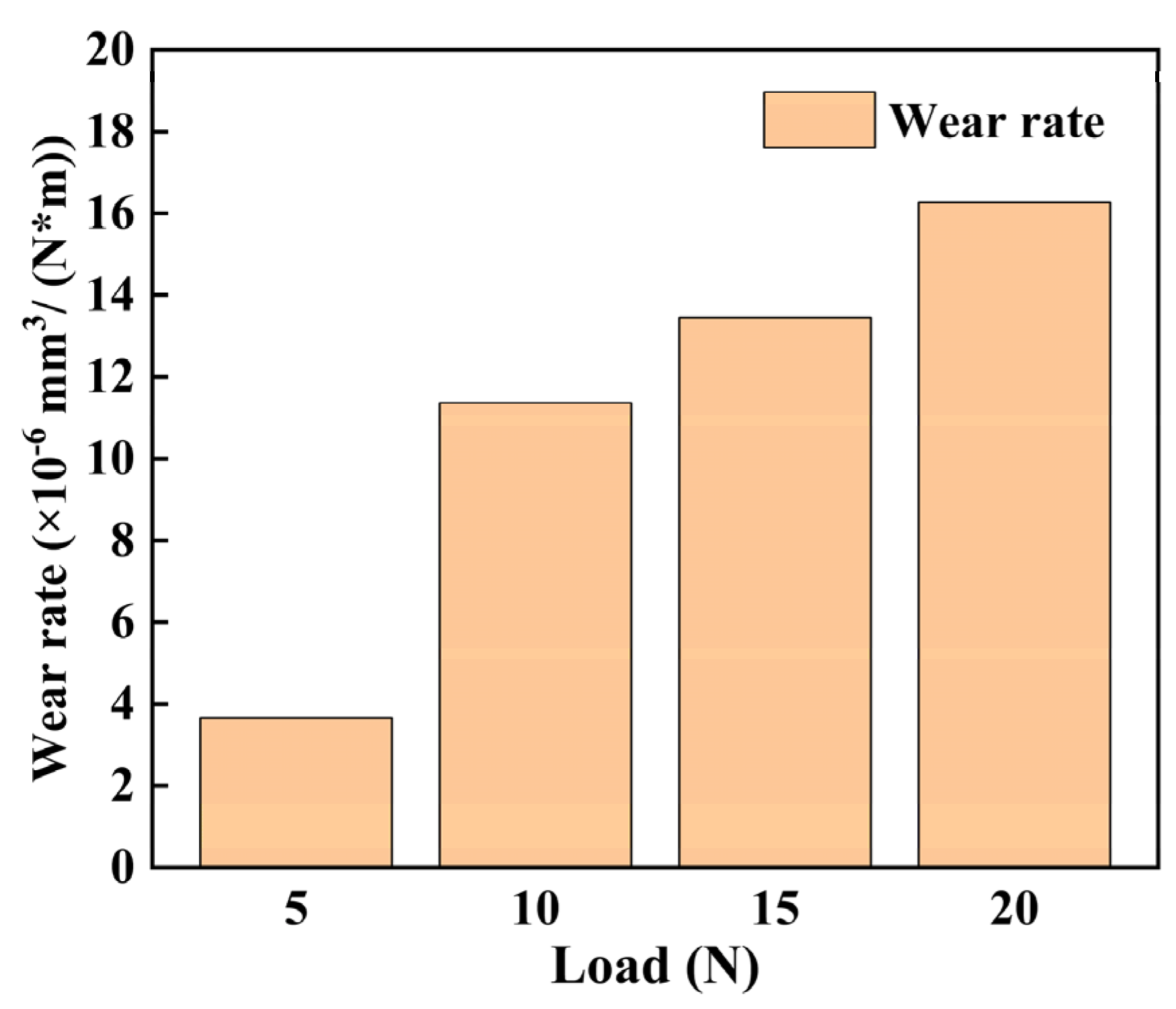

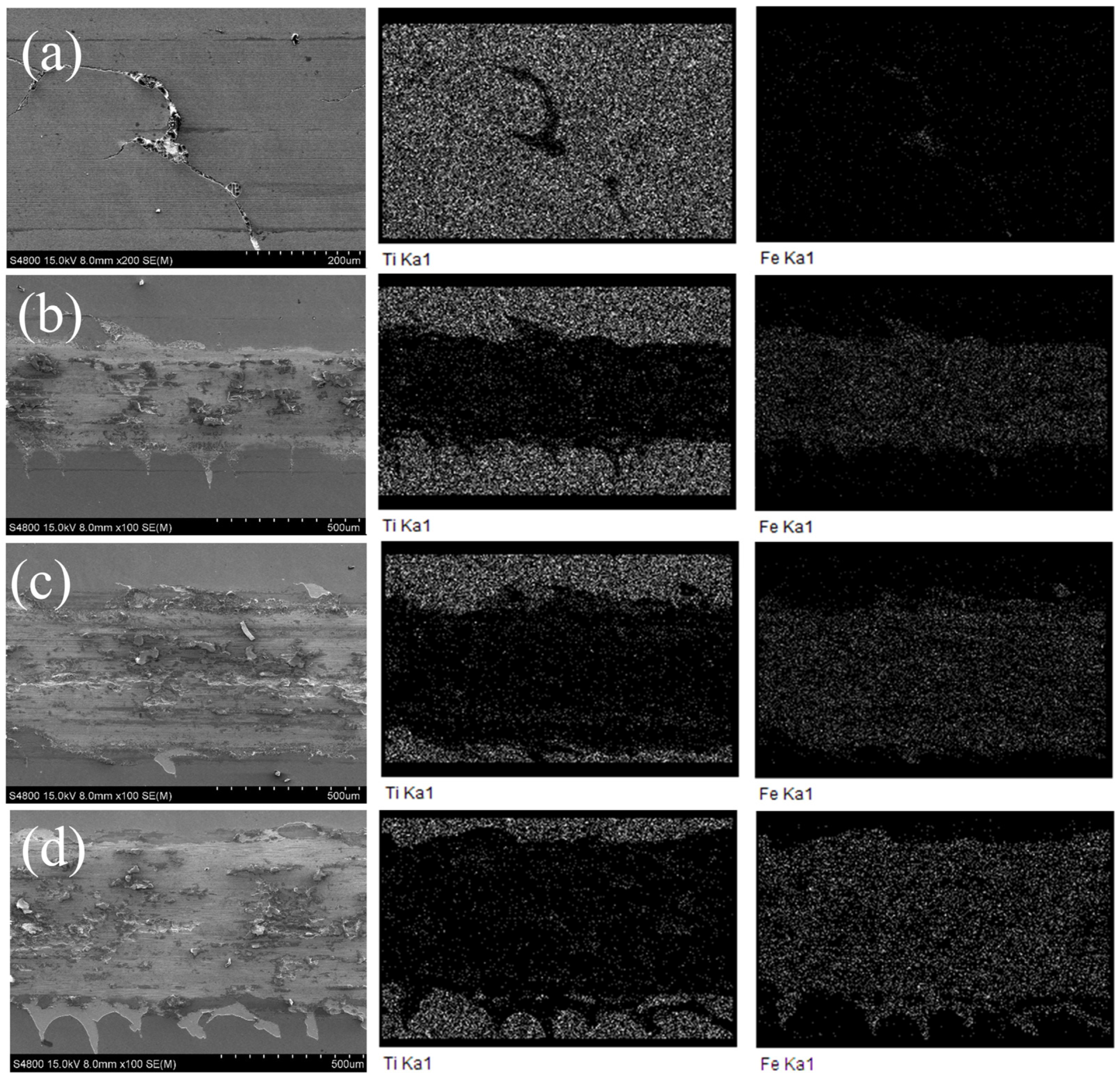

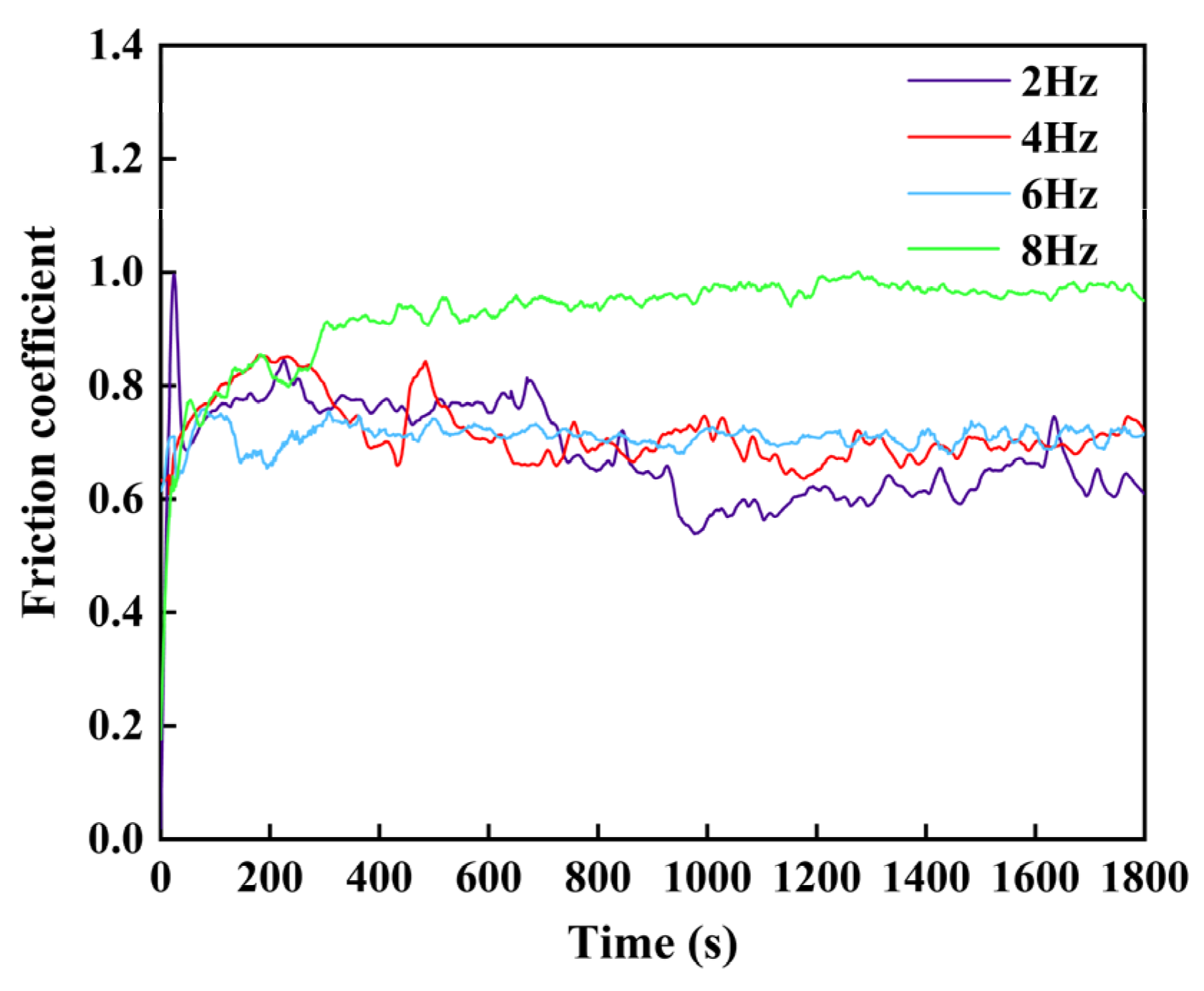



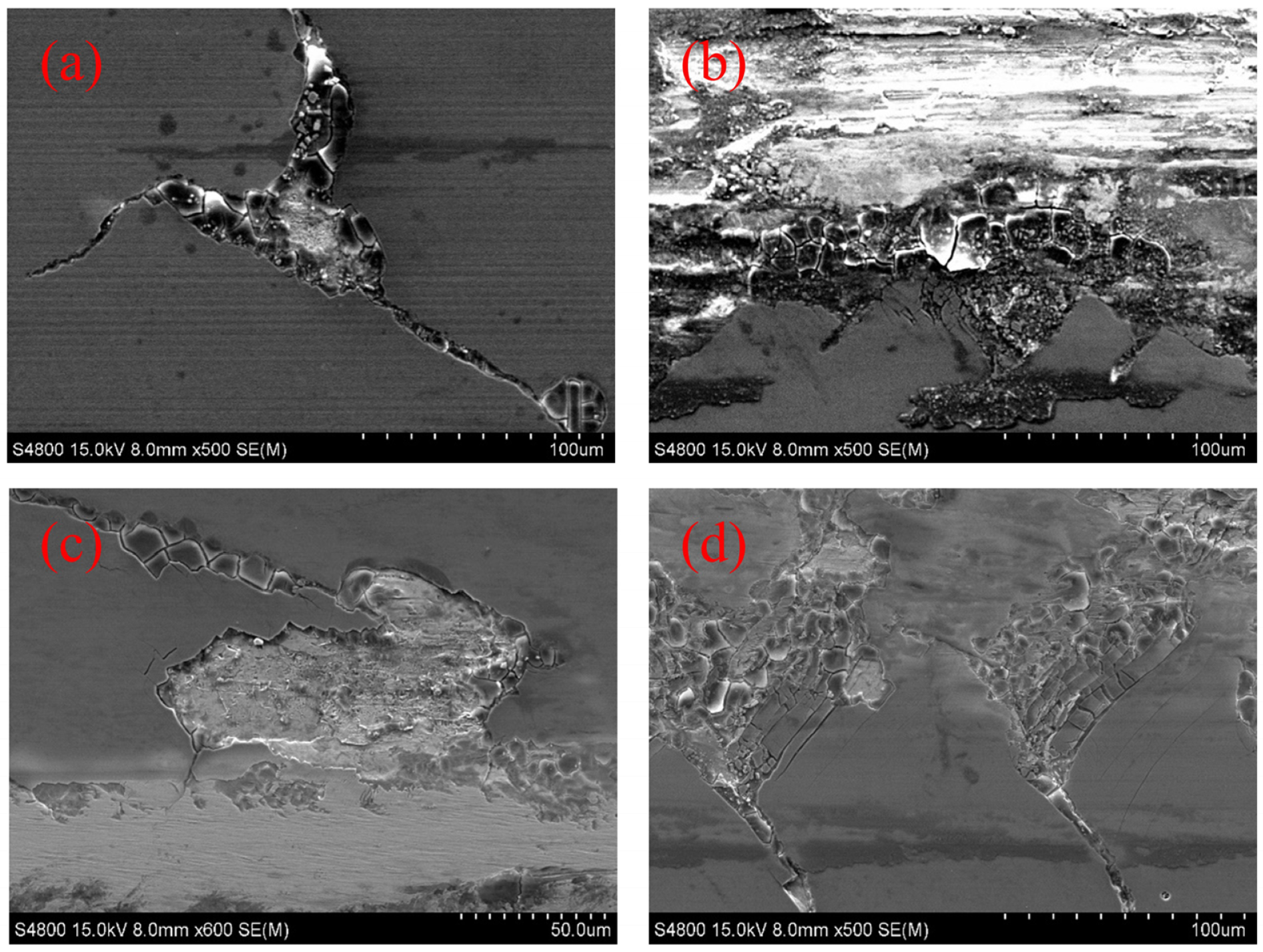
| Sample | H (GPa) | E (GPa) | H/E | H3/E2 |
|---|---|---|---|---|
| TiB2 | 24.17 | 256.80 | 0.0941 | 0.2141 |
| Friction Load (N) | Total Sliding Length (m) | Wear Volume (μm3) | Wear Rate (10−6 mm3/(N·m)) |
|---|---|---|---|
| 5 | 36 | 658,448 | 3.66 |
| 10 | 36 | 4,089,657 | 11.36 |
| 15 | 36 | 7,263,526 | 13.45 |
| 20 | 36 | 11,716,428 | 16.27 |
| Sliding Frequency (Hz) | Total Sliding Length (m) | Wear Volume (μm3) | Wear Rate (×10−6 mm3/(N·m)) |
|---|---|---|---|
| 2 | 36 | 658,448 | 3.66 |
| 4 | 72 | 706,489 | 1.96 |
| 6 | 108 | 1,994,995 | 3.69 |
| 8 | 144 | 2,895,787 | 4.02 |
Disclaimer/Publisher’s Note: The statements, opinions and data contained in all publications are solely those of the individual author(s) and contributor(s) and not of MDPI and/or the editor(s). MDPI and/or the editor(s) disclaim responsibility for any injury to people or property resulting from any ideas, methods, instructions or products referred to in the content. |
© 2024 by the authors. Licensee MDPI, Basel, Switzerland. This article is an open access article distributed under the terms and conditions of the Creative Commons Attribution (CC BY) license (https://creativecommons.org/licenses/by/4.0/).
Share and Cite
Yu, J.; Zhang, P.; Ying, P.; Lin, C.; Yang, T.; Wu, J.; Li, C.; Huang, M.; Levchenko, V. Tribological Properties of Hard TiB2 Thin Films Prepared at Low Temperatures Using HiPIMS. Coatings 2024, 14, 492. https://doi.org/10.3390/coatings14040492
Yu J, Zhang P, Ying P, Lin C, Yang T, Wu J, Li C, Huang M, Levchenko V. Tribological Properties of Hard TiB2 Thin Films Prepared at Low Temperatures Using HiPIMS. Coatings. 2024; 14(4):492. https://doi.org/10.3390/coatings14040492
Chicago/Turabian StyleYu, Jianjian, Ping Zhang, Puyou Ying, Changhong Lin, Tao Yang, Jianbo Wu, Chen Li, Min Huang, and Vladimir Levchenko. 2024. "Tribological Properties of Hard TiB2 Thin Films Prepared at Low Temperatures Using HiPIMS" Coatings 14, no. 4: 492. https://doi.org/10.3390/coatings14040492





